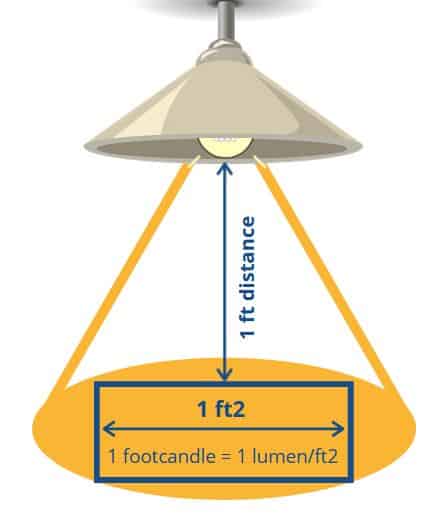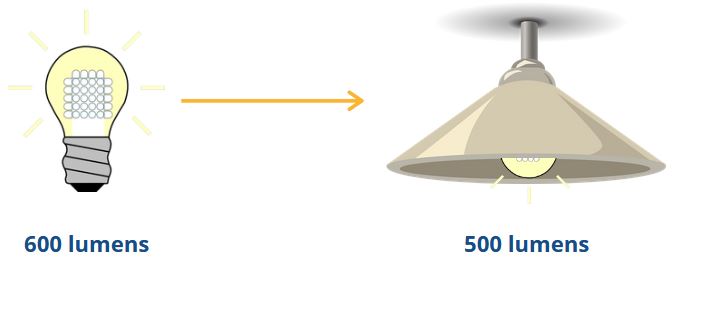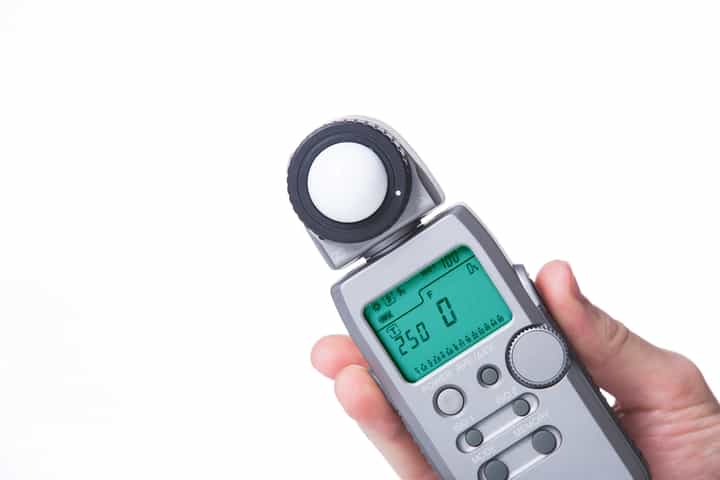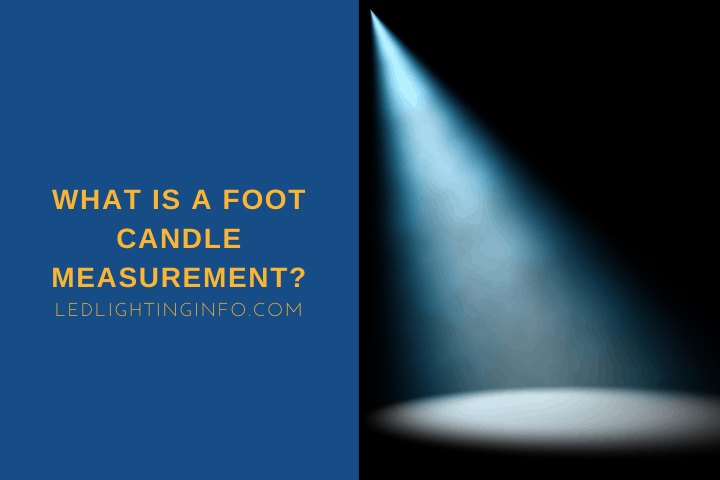When it comes to measuring a bulb’s brightness and efficiency, you’ll typically see it advertised in lumens. However, adequately lighting an area isn’t just about buying the right brightness of a bulb.
There are other factors to consider, such as the placement of light fittings, including direction and distance, or any obstacles that can partially block the light source. That’s where the foot-candle becomes a useful measurement.
A foot-candle is a measurement of light intensity in an area. Instead of measuring the light at the source, it measures the brightness of the space being lit. One foot-candle is equal to one lumen of brightness per square foot, measured at a foot from the light source.
If that sounds a little tricky, don’t worry. In this article I’m going to go into more detail on:
- What a foot candle is
- The difference between foot candles and lumens
- How to measure foot candles
What Is A Foot Candle?

A foot-candle is an imperial measurement of how intense light is within an area. There’s a metric equivalent, which is lux.
Foot candles are still widely used throughout the US, where imperial measurements are widespread.
Foot candles are either written in full or as “fc” or “lm/ft2,” which means lumens per square foot.
It’s used to describe how bright a light is in an area, with the standard measurement of the one-foot candle being the equivalent of one lumen of brightness, covering one square foot, from a distance of one foot from the light.
For comparison, a lux is the same kind of measurement, but it measures light in square meters rather than square feet. If you ever need to compare the two, just remember that one foot-candle is the same as 10.76 lux.
If you have the foot candle measurement and want to know lux, multiply by 10.76. And if you have the lux and want the foot candles, divide by the same number.
What Is The Difference Between Foot Candles And Lumens?

The easiest way to explain the difference between foot candles and lumens is with an example. So, imagine you’ve just bought a brand-new LED bulb to fit in your home. Say it’s rated at 6W, which means it’s likely to generate around 500 lumens of brightness.
When you install that bulb, it’s going to create that amount of light pretty consistently. So, you add it to your light fitting. But then you decide to add a lampshade to the fitting.
Has the brightness of the bulb itself changed? No, it’s still doing its thing and producing the same amount of light.
But you’ve affected the amount of light within the room because you’ve directed and blocked part of the light – so the area under the bulb won’t be affected, but the room overall will have fewer foot candles.
Here’s another quick example. Most smartphones let you switch on the flash to use as a torch, so do that now and hold it above a surface, like your desk.
Now move the phone up and down. The flash stays just as bright, but the surface gets dimmer the further you move the phone away.
It might seem like I’m patronizing you with basic science, but it’s the easiest way to show the difference between lumens and foot candles.
And the point is that, when planning the lighting for a room, it’s not just a case of buying brighter bulbs. You need to think about where fittings are placed, and how they’re directed, as well as any potential obstacles.
Obstacles don’t have to be permanent too. If you’re designing a kitchen, think about how often you’ll be stood at a countertop prepping your meals.
Without you blocking the light, the foot candles might be sufficient. But if the light is further away from the countertop, your shadow could make it harder to see.
A light that’s closer to the wall keeps foot candles more consistent since you’ll block less light. It’s why spotlights are so popular in kitchens, as there’s better light coverage even with you using the kitchen.
Can You Measure Foot Candles With A Light Meter?

It’s possible to measure foot candles using a light meter.
They’re pretty cheap tools – you can find them on Amazon for less than $40, if you’re only measuring white light. Most light meters give you the option of reading in lux or foot-candles, so you don’t need to do the mental arithmetic yourself.
Simply place the meter on the surface you want to measure, and it’ll give you a reading. Don’t hold it away from the surface; it’ll be inaccurate.
Depending on the room you’re measuring, you should use a light meter on the most important surface. So in your office or dining room, you’ll want to measure light on the desk or table.
However, you might want to check the light intensity on the floor for commercial buildings so that any potential hazards are definitely visible.
Or, if you’re lighting a sporting venue such as a tennis court, you’ll want the surface to be measured so that players aren’t arguing over shots due to poor lighting on the lines.
Check out my guide on using a lux meter for more information.
How Bright Is 5 Foot Candles?
The brightness of 5-foot candles is generally a more dim light that you’d expect in either a corridor in your home or in a typical store environment for a more commercial example.
The Illuminating Engineering Society of North America (IESNA) has produced a handbook which gives recommendations on the foot candles you should be aiming for.
In terms of your home, you’ll want between 20 and 30-foot candles for your bedroom or up to 75-foot candles for your kitchen, where you’ll potentially need better visibility to cook.
Thinking commercially, it’s recommended that parking garages have around 5 to 10-foot candles, offices between 30 and 50, and for professional laboratories where precise measurements are needed, between 75 and 120-foot candles.
Final Words
Between Watts, Lumens, Kelvins, Foot Candles, and Lux, there’s a lot to think about when it comes to how bright a light is.
Don’t let it confuse you, though, and remember to use my guide to Kelvins and Lumens if you need help with those.
Foot candles, and lux, are a really useful measurement for understanding how to revamp your lighting solution for your home or for a commercial property you’re working on.
With the help of a light meter, you can judge whether the room is being properly lit or whether you need to rethink your choice of bulb and light fittings.
Have you used a lux or light meter before to check the foot candles in a room? And are you a foot-candle user, or do you use lux when you take your measurements?
Let me know in the comments.
Looking for an LED bulb but not sure what type you need?
Check out my free bulb picker and select the right bulb within few clicks.

